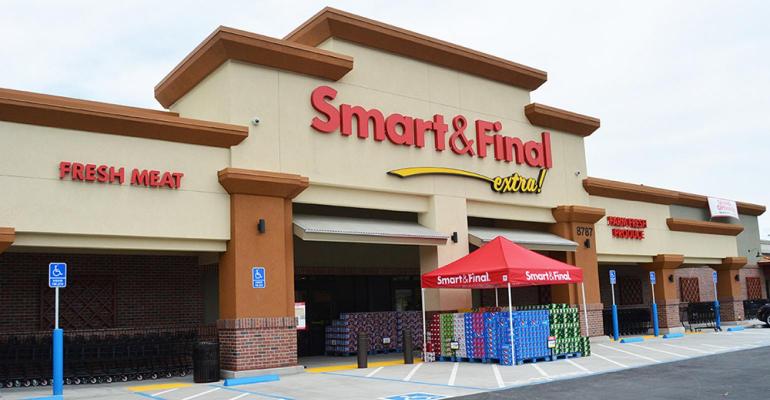After acquiring 33 supermarkets from Haggen last year, Smart & Final still sees the opportunity for 100 more new stores in California, Dave Hirz, president and CEO of Smart & Final, told SN.
“When we went public at end of 2014, we told the Street we thought there were about 100 [potential new] locations in California,” he said. “Now after a couple of years of big growth — 20 stores in 2015, and then 33 stores last year — there are still over 100 locations available, just because we have learned we can put stores a little closer together than we thought we would need to.”
Converting the acquired Haggen stores to the Smart & Final Extra! banner, along with other relocations and conversions, contributed a 2.3% hit to comparable-store sales at other locations, the company said in its year-end earnings call. Cannibalization is expected to be around 0.5% going forward, Hirz said in the call.
In addition to the 100 potential new locations in California, the company also sees the opportunity for 20 additional Smart & Final locations in Arizona and Nevada and 45 in the Pacific Northwest, a region it has yet to enter with the Smart & Final Extra! banner, but where it already operates the Cash & Carry banner.
After slowing its opening pace to 15 new Smart & Final stores this year, about 28 new stores are planned for 2018, with several in Northern California and some in Southern California, Arizona and Nevada. The company ended 2016 with 246 Smart & Final stores, including 172 Extra! banner stores and 74 legacy Smart & Final locations.
Mix of new and acquired locations
The growth plans for 2017 and 2018 call for about a 50-50 mix of new construction and acquisition of existing buildings, Hirz said.
While its first choice is to construct new stores though reverse build-to-suit leases, Smart & Final has historically done well in acquired locations that previously had been more traditional supermarkets such as Albertsons, he said.
“We have had a lot of luck converting competitors’ stores to the Smart & Final Extra! banner, so any time the conventional folks are closing stores, we take the opportunity to look at them,” Hirz said. “Normally when we buy a location from one of the major chains, it’s a location where they were not successful, and in general they work out well for us.”
One difference in most traditional stores is the size of the back rooms, he explained. Smart & Final stores product on overhead racks, warehouse style, to minimize labor costs, which reduces its need for back-room storage.
While the company will continue to examine large acquisition opportunities if they arise, Hirz said the Haggen stores were an exceptional opportunity that Smart & Final had been investigating even before Haggen filed bankruptcy.
“What was ideal there is that they were empty buildings — they were dark, so we didn’t have to worry about transitioning of store associates, and we didn’t have to worry about opening them right away … so we could go in and remodel,” Hirz explained. “It was a pretty perfect situation for us.”
Unlike more typical store acquisitions in which stores are shuttered because of poor performance, that was not the case with the Haggen stores. The locations previously had been good-performing Albertsons and Vons units that had been sold to Haggen to satisfy antitrust concerns around the Safeway-Albertsons merger, Hirz said.
Flexible store box
The ideal footprint for the Smart & Final Extra! format is about 30,000 square feet, but the company has been successful in buying larger existing buildings — 10 of the acquired Haggen stores measured around 50,000 square feet — and subdividing a portion of the site to other retailers, such as Staples or Auto Zone, Hirz explained.
Smart & Final Extra! stores also tend to perform equally well across income strata, he said, which opens up opportunities for site selection.
“We have some stores where the median income in a two-mile radius is $25,000, and some where the median income in a two-mile radius is $90,000-plus, and we do really well in both,” Hirz said. “Value is ‘the new normal,’ and people are looking for value no matter what their income, for the most part.”
Hirz said he’s confident in the company’s ability to support planned growth from a distribution standpoint. It owns and operates two distribution centers — one dry, one perishable — and has four DCs operated by third parties.
The perishables warehouse, which Smart & Final acquired from Wild Oats in 2007, underwent a $6 million renovation last year, when about 70,000 square feet of dry space was put under refrigeration. The Riverside, Calif., facility supplies all of the meat, produce, deli and dairy items for Smart & Final.
“We have a lot of potential for expansion and growth with that,” said Hirz.
In the Cash & Carry banner, the company added four new stores in 2016, including its first Utah location, bringing the total to 59 stores. It plans another four new Cash & Carry stores in 2017, including its first in Montana.





